Transform Your Bedroom with Modern Ceiling Lighting
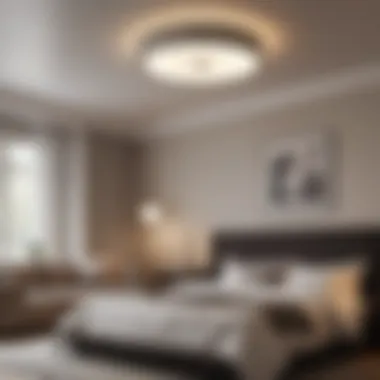
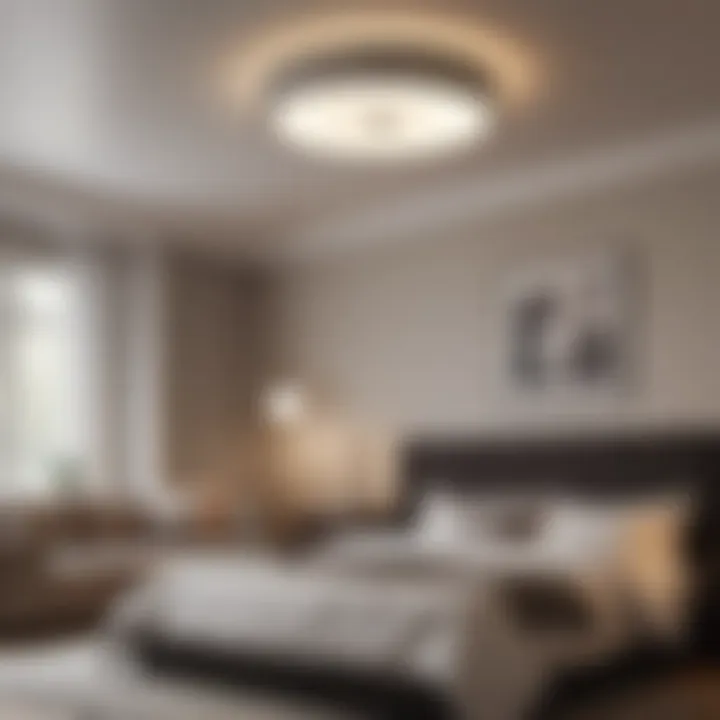
Intro
Lighting plays a crucial role in creating the perfect ambiance in any space, particularly in the bedroom. Modern ceiling lighting has evolved beyond mere functionality; it is now an integral part of interior design. This article explores the diverse styles and types of ceiling lighting currently favored in bedroom design. Understanding these aspects can change the overall mood and efficiency of the space.
Moreover, as technology advances, innovative lighting solutions have emerged, providing homeowners and design enthusiasts with various options. Exploring these concepts helps us recognize the impact modern ceiling lighting has on aesthetics and functionality, ultimately transforming how we experience our bedrooms.
Design Inspiration
Current Trends in Interior Design
Modern ceiling lighting trends reflect a blend of style and advanced technology. Minimalism remains a strong influence, favoring clean lines and understated elegance. Fixture styles range from sleek pendant lights to integrated LED panels, which enhance space without overwhelming it.
In contrast, vintage and rustic styles are also gaining momentum. Industrial designs with metal finishes and reclaimed wood accents infuse warmth and character into the bedroom. The key is finding balance, ensuring the choice of lighting complements existing decor while reflecting personal taste.
Color Schemes and Palette Ideas
When selecting ceiling lighting, consider the color scheme of the bedroom. Lighter tones can enhance the feeling of space, making fixtures like white or soft grey blend seamlessly with walls. Darker colors can create a dramatic effect, especially when paired with warm light bulbs.
The choice of color directly affects mood. For instance, soft pastels may invoke tranquility, while bold colors can energize the atmosphere. It is advisable to align your lighting choices with the overall color palette of the room to achieve harmony.
"Lighting has the power to change the perception of a room, making it cozy, spacious, or vibrant depending on how it’s applied."
Culmination
Modern ceiling lighting is not just about illumination. It holds the potential to dramatically influence bedroom design. Selecting the right style and understanding current trends allows homeowners to create spaces that are both functional and aesthetically pleasing. With practical tips and insights, anyone can enhance their bedroom experience through thoughtful lighting choices.
Prologue to Modern Bedroom Lighting
Modern ceiling lighting has evolved significantly, providing practical solutions and aesthetic enhancements for bedroom design. Understanding this evolution is essential for homeowners and design enthusiasts, as it reflects changing styles, technologies, and preferences in personal spaces. Good lighting balances form and function, allowing individuals to express creativity while fulfilling everyday needs.
The importance of ceiling lighting in the bedroom cannot be overstated. It serves not only to illuminate but also to define the mood and feel of the space. Smart use of ceiling fixtures can create an inviting ambiance, whether one seeks restfulness at the end of the day or energy in the morning.
Furthermore, modern ceiling lighting includes various types and styles that can complement different interior themes. This article delves into the various aspects of modern lighting choices, exploring their functionalities, designs, and the effects they have on how a bedroom is perceived and experienced. With advancements in technology, now one can choose from smart systems and eco-friendly options, making the introduction of modern lighting a vital consideration in contemporary bedroom design.
The Evolution of Bedroom Lighting
Historically, bedroom lighting was a straightforward affair, limited mainly to chandeliers or wall sconces. These fixtures predominantly created general light without much regard for task-specific needs. However, the rise of the modern era has changed this perspective. The focus has shifted from mere functionality to incorporating design and efficiency into lighting choices. This shift has been driven by the burgeoning interest in interior design and the pivotal role that lighting plays in creating atmosphere.
In recent decades, energy-efficient solutions such as LED technology have reshaped how we think about bedroom illumination. Not only do these options reduce energy consumption, but they also offer users longer lifespans and versatility in light output. Over time, bedroom lighting has transitioned to a more layered approach, incorporating various forms of light sources that enhance both aesthetics and functionality.
Why Ceiling Lighting Matters
Ceiling lighting plays a critical role in the overall design and ambiance of a bedroom. It is the principal source of illumination, impacting not only visibility but also the emotional state of the inhabitants. A well-appointed ceiling fixture can serve as a focal point, drawing attention and complementing other decor elements in the room.
The positioning and quality of ceiling lights influence how space is perceived and can make small areas appear larger or cramped. Here are some important points regarding why ceiling lighting matters:
- Versatility: Modern fixtures come in diverse forms, allowing for a variety of styles ranging from sleek minimalism to ornate designs.
- Mood Influencer: The type of light used can set different moods, from bright and invigorating in the morning to soft and relaxing in the evening.
- Functional Needs: Effective ceiling lighting fulfills essential tasks, such as reading in bed or selecting outfits in the morning, enhancing the overall functionality of the space.
"Effective ceiling lighting can transform not just the room but also the quality of life for its inhabitants."
Indeed, the significance of modern ceiling lighting in bedroom design cannot be overlooked. It is an essential component that intertwines functionality with artistry, working collaboratively with other elements in the space to create an ideal living environment.
Types of Modern Ceiling Lighting
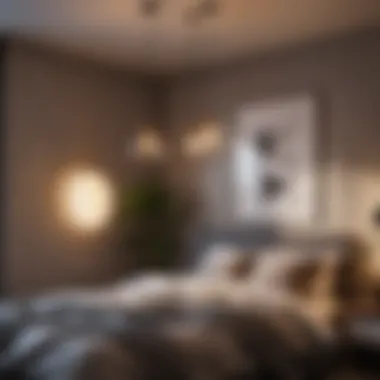
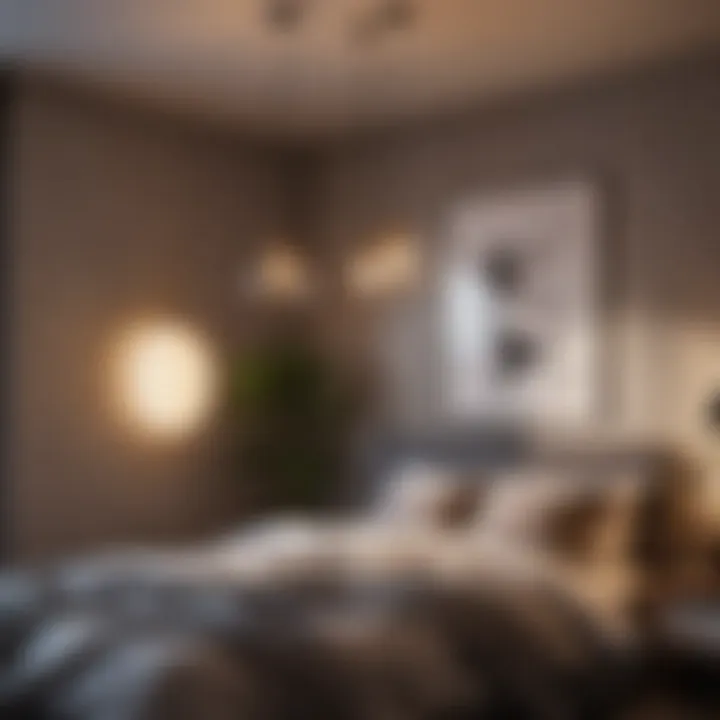
The selection of ceiling lighting is critical in creating a functional and visually appealing bedroom environment. Modern designs offer an array of options to fit personal styles and practical needs. Understanding different types of ceiling lighting is essential for both aesthetic coherence and meeting the functional requirements of a bedroom. The various forms of ceiling lighting not only illuminate but also add character and depth to the space.
Pendant Lights
Pendant lights serve as a prominent choice for modern bedroom lighting. They come in a variety of styles, sizes, and materials which make them versatile for different design themes. Their unique appeal lies in their ability to act as a statement piece while still providing significant illumination.
One benefit of pendant lights is the option to adjust their height, allowing for customization of light levels and ambiance. They are ideal for positioning over specific areas like bedside tables or cozy reading nooks. Considerations when choosing pendant lights include the size of the room and the height of the ceiling, as an oversized pendant in a small room may feel overpowering, while small pendants in large rooms can seem lost.
Chandeliers
Chandeliers have long been associated with elegance and sophistication. In contemporary bedroom settings, they can range from minimalist designs to more elaborate options, fitting various aesthetic approaches. Modern chandeliers often blend materials like metal, glass, and fabric, making them more than just a light fixture; they become an art piece.
The lighting provided by chandeliers not only enhances visibility but also elevates the overall decor of the bedroom. A well-placed chandelier can serve as a focal point, drawing the eye and setting the tone for the space. However, it's crucial to ensure they are installed at an appropriate height to avoid crowding the room visually.
Flush Mount Fixtures
Flush mount fixtures offer clean, unobtrusive lighting solutions ideal for spaces with lower ceilings. They provide a seamless look that avoids cluttering the vertical space while ensuring adequate light distribution. These fixtures are especially useful in smaller bedrooms or where ceiling height is restricted, perfect for maximizing the room's functionality without sacrificing style.
A wide range of designs is available in flush mount fixtures, from contemporary geometric shapes to classic circular formats. Their low-profile appearance keeps the aesthetic simple while still contributing significantly to the room's lighting scheme. Key considerations include matching the design with the overall style of the bedroom and ensuring the light output meets the user's needs.
Recessed Lighting
Recessed lighting is a sophisticated choice that offers versatility and functionality. This type of lighting involves installation in the ceiling, creating a streamlined look that can brighten the entire room without bulky fixtures getting in the way. The beauty of recessed lighting lies in its ability to provide ambient light while allowing other decorative fixtures to shine.
These lights are ideal for layered lighting schemes, as they can be strategically placed to enhance specific areas or tasks. Dimmer switches can be a great addition, allowing for mood control based on the time of day or activity. Consider the placement carefully to avoid overly bright spots and ensure an even light spread throughout the room.
Track Lighting
Track lighting is another modern solution that offers flexibility and a degree of control over illumination. It consists of a series of lights mounted on a track, allowing the user to focus light where needed. This system is particularly effective in bedrooms with multiple zones for activities, such as reading, studying, or dressing.
Users can change the direction of individual heads on the track, tailoring the light for specific tasks or creating various moods. One consideration is ensuring the track complements the room’s design while avoiding a cluttered look. Track lighting can integrate well into both minimalist and elaborate decor styles, providing a modern edge to traditional settings.
Design Styles and Aesthetics
Understanding design styles and aesthetics is vital when discussing modern ceiling lighting in bedrooms. The choice of lighting not only influences the functionality of the space but also contributes significantly to the overall aesthetic appeal. Ceiling lighting serves as a centerpiece that can reflect the design philosophy of a bedroom, be it minimalist, rustic, or industrial. By paying attention to these elements, homeowners can create a cohesive and inviting atmosphere that resonates with personal taste.
Minimalism
Minimalism is a design style that values simplicity and clean lines. In a minimalist bedroom, ceiling lighting should complement this ethos. Fixtures should be streamlined and unobtrusive, often utilizing neutral colors like white or black to blend seamlessly into the background. LED recessed lighting is a popular option in this context. It provides sufficient illumination without taking up visual space, helping to maintain the serene ambiance typical of minimalist design. Moreover, the strategic placement of light sources can enhance the feeling of spaciousness, making the room appear larger than it actually is.
Scandinavian Design
Scandinavian design emphasizes function and warmth, incorporating natural materials and light colors. In a Scandinavian bedroom, ceiling lighting plays a crucial role in achieving a cozy atmosphere. Pendant lights with wooden or fabric elements often feature prominently. These fixtures not only provide general illumination but also serve as decorative accents that enhance the room's aesthetic. Choosing light bulbs with a warm color temperature can augment the comfort level, creating a welcoming environment. Layering lighting with ambient options, such as wall sconces, further enriches the design.
Industrial Style
The industrial style draws inspiration from warehouses and factories, characterized by raw materials and exposed elements. In an industrial bedroom, ceiling lighting is often bold and statement-making. Chandeliers or pendant lights made from metal can elevate the industrial aesthetic. The use of Edison bulbs reinforces the theme, casting a warm glow that softens the hard materials typical of this design. It is essential to ensure that these light fixtures do not overwhelm the space but instead complement the rugged beauty of the industrial style.
Modern Farmhouse
Modern farmhouse design combines contemporary comfort with rustic charm. In a modern farmhouse bedroom, ceiling lighting should embody this blend. Fixtures like flush mount lights or lantern-style chandeliers can effectively bridge the gap between old and new. The use of materials such as wood and wrought iron can add an organic touch. Opting for fixtures that feature vintage design elements can enhance the farmhouse vibe. Ensuring that the lighting is adjustable can offer versatility, allowing for different moods depending on the time of day or occasion.
"The right ceiling lighting can transform a bedroom, making it not just a place to sleep but a reflection of personal style."
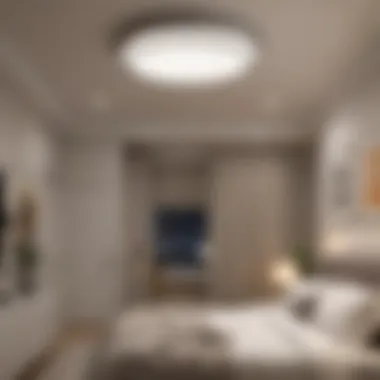

In summary, the design styles and aesthetics of a bedroom significantly impact the selection and placement of ceiling lighting. Each style, from minimalism to modern farmhouse, offers unique opportunities to enhance the space's beauty and functionality. Homeowners should consider these aspects carefully to create an environment that resonates with their tastes and needs.
Functional Considerations in Lighting Design
In the realm of bedroom design, functional considerations play a pivotal role in determining how space is used and experienced. Lighting serves not just as a tool for visibility, but also as an integral element that influences the overall ambiance and functionality of the room. It goes beyond aesthetics, embedding practicality into the design through a strategic layering of light sources. This multi-dimensional approach helps in optimizing both the visual and emotional experience within the bedroom.
Layering Light Sources
Layering light sources is a fundamental concept in effective lighting design. By combining different types of lighting, homeowners can create a space that is adaptable to various activities and moods.
Ambient Lighting
Ambient lighting is the primary layer that sets the overall illumination of the room. It can derive from different sources, such as ceiling fixtures or wall sconces. The key characteristic of ambient lighting is that it provides a soft, diffused light that fills the space evenly. This makes it a beneficial choice for bedrooms, promoting relaxation and comfort. One unique feature of ambient lighting is its versatility; it can be adjusted according to personal preference, making it suitable for various moments, whether that is winding down for the day or waking up in the morning.
Advantages of ambient lighting include:
- Inclusivity: It allows for unobtrusive visibility throughout the room, enhancing safety and accessibility.
- Mood Setting: It contributes significantly to the overall mood, making the space feel warm and inviting.
Disadvantages may include:
- Over-lighting: There can be a risk of creating a bland atmosphere if not balanced with other light types.
Task Lighting
Task lighting focuses on illuminating specific areas or activities, such as reading or working. It is characterized by its directed light, which helps in performing tasks efficiently. This type of lighting is popular in bedroom settings where individuals may need to engage in more focused activities. For instance, bedside lamps provide essential light for reading without disturbing a partner’s sleep.
A unique feature of task lighting is its adaptability. It can be installed in various forms, such as adjustable wall sconces or floor lamps, to suit different needs and preferences.
Advantages of task lighting include:
- Functionality: It enhances the practicality of the space by providing necessary light for specific tasks.
- Personalization: Users can customize settings based on individual hobbies or routines.
However, its disadvantages could be:
- Limited Use: If relied upon solely, it may not cover the entire room effectively and lead to uneven lighting.
Accent Lighting
Accent lighting highlights specific features in the room, such as artwork or architectural elements. The key characteristic of accent lighting is its ability to draw attention and create visual interest. This makes it a beneficial choice for enhancing the aesthetic appeal of the bedroom. For instance, using wall-mounted picture lights to showcase artwork adds character and depth to the space.
One unique feature of accent lighting is its potential to transform the room’s feel. Incorporating colored accent lights can further create a playful atmosphere or define particular zones within the bedroom.
Advantages of accent lighting include:
- Enhancement: It enriches the overall design by providing layers and creating focal points.
- Ambiance: It can change the mood of the room and complement other lighting layers effectively.
Disadvantages may be:
- Overuse: Too much accent lighting can create a cluttered look and may divert attention from the main purpose of the space.
Color Temperature and Mood
Choosing the right color temperature is crucial in lighting design as it significantly impacts mood and perception. Warmer tones tend to create a cozy environment, perfect for relaxation, while cooler tones can invigorate and promote alertness. Selecting appropriate color temperatures can enhance the functional aspects of a bedroom, supporting various activities from restful sleep to productive work.
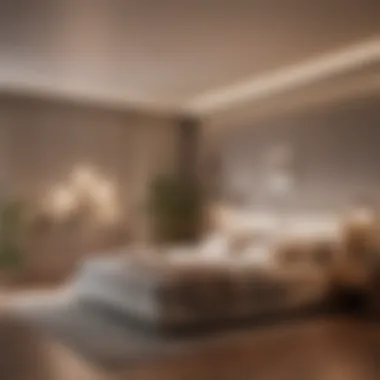
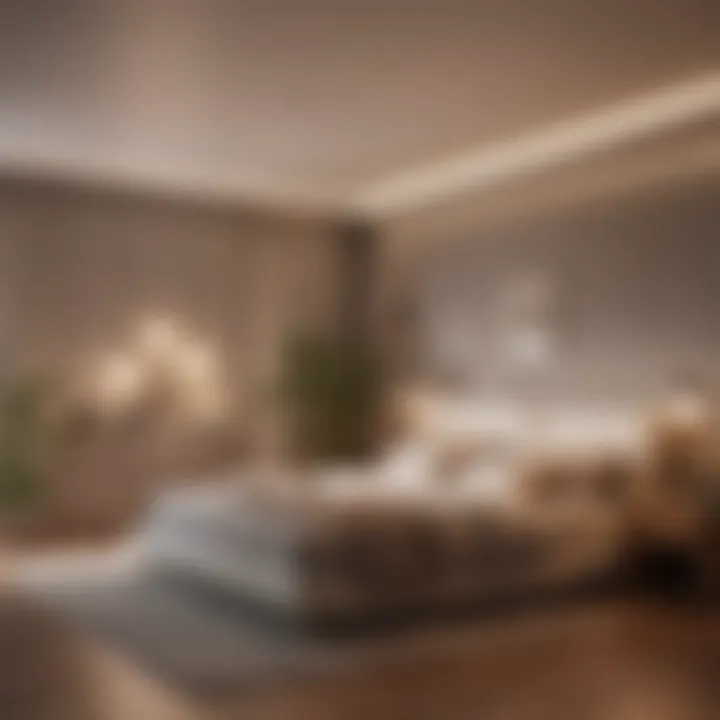
Current Trends in Bedroom Lighting
In the realm of bedroom design, ceiling lighting trends are evolving, reflecting broader shifts in aesthetics, technology, and sustainability. Recognizing these current trends is essential for homeowners, interior design enthusiasts, and anyone keen on transforming their bedroom spaces. Not only do they enhance the look of a room, but they also offer functional benefits that may improve daily living.
Smart Lighting Systems
Smart lighting systems have emerged as a prominent trend in modern bedroom design. These systems allow homeowners to control lighting remotely through smartphone apps or voice commands. The convenience of adjusting the brightness or changing the color temperature from anywhere in the house adds significant value. This technology goes beyond mere aesthetics; it enables personalized lighting experiences that can adjust according to activities or moods.
- Integration with Home Automation: Smart lighting can be seamlessly integrated into home automation systems, providing an interconnected environment. Homeowners can create lighting schedules, use motion sensors, or control lighting remotely, enhancing both comfort and security.
- Energy Efficiency: Many smart systems utilize LED technology, which is far more energy-efficient compared to traditional bulbs. This translates to long-term cost savings and a reduced carbon footprint.
- Mood Enhancement: Smart lighting can influence your mood. For instance, warmer colors can create a comforting atmosphere for relaxing, while cooler tones can be stimulating for productivity. Adjusting the light to suit various activities can drastically improve living quality.
Eco-Friendly Options
As concerns about sustainability continue to rise, eco-friendly lighting options have gained traction in the bedroom design landscape. The choice of materials and the environmental impact of lighting fixtures are becoming increasingly significant for many homeowners. Here are a few considerations and benefits of eco-friendly lighting:
- Sustainable Materials: Many modern ceiling lights are crafted from sustainable or recycled materials. Choosing fixtures made from bamboo, reclaimed wood, or recycled metal can add character and contribute to environmental conservation.
- Energy-Efficient Bulbs: The introduction of energy-efficient bulbs, such as LED lights, minimizes electricity usage. These bulbs last significantly longer than incandescent or halogen counterparts, leading to reduced waste and lower replacement costs.
- Natural Light Utilization: Some designs emphasize maximizing natural light through strategically placed fixtures and mirrors, reducing the need for artificial lighting altogether during daylight hours. This serves not only to enhance aesthetic appeal but also promotes well-being by fostering connections with the outside environment.
"Investing in eco-friendly lighting not only benefits the planet but also improves your space’s ambiance."
With these trends, modern ceiling lighting does not merely serve as a visual or functional element; they embody lifestyle choices reflecting personal values and aesthetics. Embracing smart technology or eco-friendly options can significantly enhance both everyday functionality and long-term sustainability in any bedroom design.
Installation and Maintenance
Effective installation and proper maintenance play pivotal roles when it comes to modern ceiling lighting in bedroom designs. Adequate installation ensures that the lighting achieves its intended purpose, optimizing both aesthetics and functionality. Poorly installed fixtures may lead to inefficient lighting, safety hazards, or even damage to the existing structures.
Maintenance, on the other hand, extends the lifespan of these fixtures, ensuring consistent performance and helping to maintain the ambiance of the space. Regular checks for wear, bulb replacement, and cleaning can keep a bedroom looking inviting and well-kept.
Installation Best Practices
Understanding best practices in installation is essential for achieving the desired lighting effects. Here are key aspects to consider:
- Assess Ceiling Height: Before any installation, measure the ceiling height. This will determine the type of fixture suitable for your space. Pendant lights, for example, require ample clearance.
- Plan the Layout: Consider the room’s specific lighting needs. A well-planned layout might include multiple fixtures to create a layered light effect, distributing light evenly throughout the space.
- Use Appropriate Wiring: Ensure that the wiring is suitable for the type of lighting you are installing. For heavy fixtures or multiple lights, consult a professional to avoid overloading circuits.
- Follow Manufacturer's Instructions: Each lighting fixture comes with its own set of instructions. Following these carefully ensures safe and effective installation.
- Test the Electrical Connections: Once installation is complete, keep safety in mind and test all connections before finalizing everything.
Maintenance Tips for Longevity
There are several maintenance practices that can greatly enhance the longevity of ceiling lighting:
- Regular Cleaning: Dust and grime can accumulate on fixtures, reducing light output. Use a soft cloth or a gentle cleaning solution to keep fixtures spotless and bright.
- Replace Bulbs Promptly: As bulbs reach the end of their life, their performance declines. Regularly check bulbs and replace them promptly to maintain consistent illumination.
- Check Electrical Components: Look for signs of wear in electrical connections and wires. Any fraying or discoloration should be addressed immediately to prevent hazards.
- Schedule Professional Inspections: If there are multiple fixtures or a complex system, scheduling annual inspections with professionals can help catch problems early.
- Use Quality Components: Investing in high-quality lighting fixtures and components will pay off in the long run, as they tend to require less frequent replacement and offer better performance.
Remember, a well-maintained lighting system not only enhances the aesthetic appeal of your bedroom but also ensures safety and energy efficiency.
Epilogue and Future Outlook
The importance of modern ceiling lighting in bedroom design cannot be overstated. As we have seen throughout this article, lighting serves as a crucial element that impacts both aesthetics and functionality. It shapes the atmosphere of a space, influences mood, and plays a significant role in creating a cohesive design.
Looking ahead, we can expect the evolution of bedroom lighting to continue in ways that marry technology with design innovation. The increasing prevalence of smart lighting systems allows for a more personalized experience. Homeowners can adjust brightness, color, and even the timing of lighting through mobile apps. This flexibility enhances comfort and functionality.
Energy efficiency is another focal point for the future. Eco-friendly lighting solutions, like LED fixtures, are not able to significantly reduce energy consumption; they also boast a longer lifespan compared to traditional options. Thus, consumers are more likely to adopt these sustainable choices.
In addition, trends toward minimalism and Scandinavian design promote simplicity and elegant functionality. These trends influence the types of lighting fixtures chosen, steering preferences towards sleek, unobtrusive designs that blend seamlessly into the decor.
"Lighting is the ultimate symbol of the control you have over your space."
This thought signifies a sum of both design and technology in contemporary lighting trends.
The Future of Bedroom Lighting
The future of bedroom lighting is bright. Innovations are constantly shaping our understanding and use of space. Key elements will include:
- Smart Technology Integration: Users will increasingly rely on apps and smart devices for customized lighting choices. This adaptability caters to individual preferences for atmosphere and energy savings.
- Increased Focus on Health and Wellbeing: Advances in lighting technology aim to enhance wellbeing, allowing for control over color temperature and intensity. This could help regulate circadian rhythms, potentially improving sleep quality.
- Sustainable Habits: A focus on reducing environmental impact leads to wider adoption of energy-efficient products. By choosing options like dimmers or motion sensors, homeowners can conserve energy while still enjoying excellent lighting.
- Versatile Designs: Bedroom lighting is becoming increasingly versatile. To meet varied needs, designers are creating fixtures that serve multiple purposes, combining aesthetics with functionality.
In summary, the intersection of technology, aesthetics, and sustainability will define the landscape of bedroom lighting in the coming years. Homeowners and designers alike must stay informed and adaptable to harness the benefits of these advancements.



